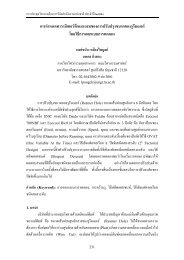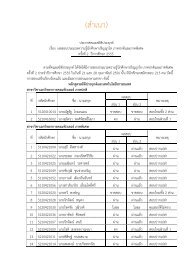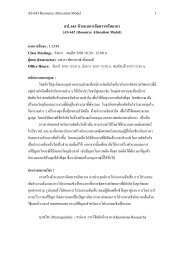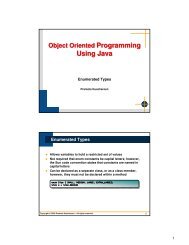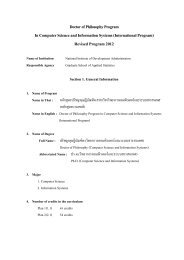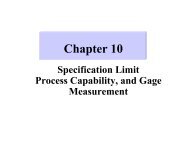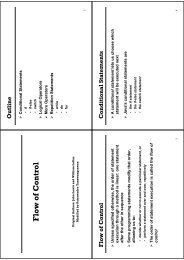ดาวน์โหลด All Proceeding - AS Nida
ดาวน์โหลด All Proceeding - AS Nida
ดาวน์โหลด All Proceeding - AS Nida
You also want an ePaper? Increase the reach of your titles
YUMPU automatically turns print PDFs into web optimized ePapers that Google loves.
บทคัดยอ<br />
156<br />
การประชุมวิชาการดานการวิจัยดําเนินงานแหงชาติ ประจําป 2554<br />
วันที่<br />
8-9 กันยายน 2554 ณ โรงแรม เอส ดี อเวนิว กรุงเทพฯ<br />
การออกแบบระบบหอกลั่นสําหรับการทําใหเอทานอลบริสุทธิ์<br />
Design of distillation system for purification of ethanol<br />
อัญชลี กาญจนบัตร 1 และ ผศ.ดร.อมรชัย อาภรณวิชานพ 2<br />
1, 2<br />
ภาควิชาวิศวกรรมเคมี คณะวิศวกรรมศาสตร จุฬาลงกรณมหาวิทยาลัย<br />
เขตปทุมวัน จ.กรุงเทพฯ 10330<br />
โทรศัพท/โทรสาร: 02-218-6878 E-mail: 1 u_kanchanabut@hotmail.com, 2 amornchai_a@chula.ac.th<br />
เอทานอลเปนหนึ่งในพลังงานทดแทนที่สําคัญที่สุด<br />
ที่ผลิต<br />
โดยการหมักน้ําตาล<br />
หรือแปงใหกลายเปนเอทานอล และกลั่นใหบริสุทธิ์<br />
มีความเขมขน 99.5% โดยปริมาตร และนํามาผสมกับแกสโซลีนใชเปน<br />
เชื้อเพลิงสําหรับรถยนตเพื่อลดการใชแกสโซลีน<br />
วัตถุดิบที่สามารถนํามา<br />
ผลิตและเปนที่นิยมชนิดหนึ่งคือแปงมันสําปะหลัง<br />
ในการผลิตเอทานอ<br />
ลกระบวนการทําใหบริสุทธิ์เปนสวนที่ใชพลังงานมากที่สุด<br />
ในงานวิจัยนี้<br />
จะทําการพัฒนาแบบจําลองเพื่อออกแบบหอ<br />
กลั่นเอทานอลสําหรับการ<br />
ใชพลังงานอยางคุมคาโดยใชโปรแกรม<br />
Aspen HYSYS ® การพัฒนา<br />
แบบจําลองหอกลั่นจะทําการปรับคาตัวแปรหลักดังนี้<br />
อัตราสวนการ<br />
ปอนกลับของสารในหอแรก, ความเขมขนเอทานอลที่ออกจากหอแรกสู<br />
หอเรคติฟายอิง และปริมาณของผลิตภัณฑที่ไดตอชั่วโมง<br />
เพื่อดูสภาวะที่<br />
ทําใหเกิดการใชพลังงานอยางคุมคามากที่สุด<br />
ผลของแบบจําลองแสดงให<br />
เห็นวาสภาวะที่ใชควบคุมของหอกลั่นคาใหมนั้นมีการใชพลังงานที่ต่ํา<br />
กวาแบบเดิมมาก<br />
คําสําคัญ: เอทานอล, การกลั่น,<br />
การนําพลังงานกลับมาใชใหม, การใช<br />
พลังงานอยางคุมคา<br />
Abstract<br />
Ethanol is one of the most important renewable fuels which<br />
is transformation of sugar or starch to ethanol by fermenting organisms<br />
and purified to 99.5%v/v by distillation. Tapioca is one of the famous<br />
raw materials used to produce ethanol. This process also consume huge<br />
amount of energy especially in purification process. In order to analyze<br />
the process viability, distillation processes are simulated and<br />
parametrically optimized to reduce energy consumptions. Simulations<br />
are carried out in steady state using the commercial simulator Aspen<br />
HYSYS ® . The simulations vary based on these key parameters: reflux<br />
ratio of mash column (R 1), volume fraction of ethanol in distillate of<br />
mash column (X D1)and distillate flow rate of rectifying column (D 2) to<br />
find the suitable condition which is able to optimize energy<br />
consumption. And simulation results show that new condition can have<br />
significantly lower energy demands than common units.<br />
Keywords: Ethanol, Distillation, Heat integration, Energy<br />
optimization.<br />
1. Introduction<br />
Presently, ethanol is accepted to be an important renewable<br />
fuel and its use can reduce negative environmental impacts originated<br />
by the worldwide utilization of biomass fuels. From the production<br />
process of ethanol, it can be seen that the aqueous solution of ethanol<br />
obtained from the fermentation is concentrated to obtain hydrous<br />
ethanol to be utilized as a fuel and an oxygenate compound for adding<br />
to gasoline. The ethanol process consists of 4 major unit operations:<br />
liquefaction and saccharification, fermentation, distillation and<br />
dehydration section to reach 99.5%v/v. The separation of azeotropic<br />
mixtures is a process demands large input of energy, more than half of<br />
the total energy used. In this case fractional distillation is chosen to<br />
produce 95%v/v ethanol concentration because it gets the most<br />
purification and high efficiency and commonly used with high capacity.<br />
But if compare on the basis of energy requirements it is still extremely<br />
high. A considerable amount of energy supplied to the reboiler was<br />
wasted at unrecoverable temperatures in the condenser. In this case<br />
distillation process is first priority section to optimize [1] the energy by<br />
using commercial simulator Aspen HYSYS ® . The simulations will be<br />
varied based on related major key parameters such as number of stage<br />
and heat transfer area to find the suitable condition which is able to<br />
optimize energy consumption.<br />
2. Theories<br />
2.1. Process Description




